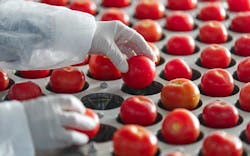A few simple, inexpensive changes in commercial processing could dramatically improve the taste of tomatoes, according to new research.
A study presented at a meeting of the American Chemical Society suggests that warming the fruit before chilling gives it a fuller flavor.
“Ideally, tomatoes should be picked ripe and then sold immediately, as they are at farm stands,” said Jinhe Bai, a plant physiologist with the U.S. Department of Agriculture’s Agricultural Research Service (ARS).
But for commercially sold tomatoes this is not always possible. Instead, they are often picked when they are still green, to prevent them becoming too ripe before they reach the store.
Packers use a gas called ethylene to trigger fruit ripening, and then the tomatoes are stored and shipped at low temperatures.
However, chilling tomatoes degrades their flavor. In an effort to improve the flavor quality, Bai and his colleagues added a hot water pre-treatment step to the usual protocol that growers follow.
They dipped Florida-grown green tomatoes in hot water (about 125 degrees Fahrenheit) for five minutes and then let them cool at room temperature before chilling to between 41 and 55 degrees Fahrenheit, the temperatures used by commercial producers for shipping. After the tomatoes fully ripened, the researchers tested them for flavor and aroma.
Results confirmed that the pre-treatment step prevented flavor loss due to chilling.
The researchers found that tomatoes heated before chilling had higher levels of flavor compounds (6-methyl-5-hepten-2-one, 2-methylbutanal and 2-phenylethanol) than non-heated fruit, and they tasted better.
“Chilling suppresses production of oxygen, nitrogen and sulfur-containing heterocyclic compounds, ketones, alcohols and aldehydes, including 13 important aroma components of tomato flavor. But hot water-treated fruit actually produced higher concentrations of these important aroma contributors, even with subsequent chilling,” Bai explained.
Another method tested by the team also proved effective in preserving flavor.
With this procedure, the researchers picked the tomatoes at a slightly later stage — when they were half green and half pink — and then treated them with 1-methylcyclopropene (a gas approved by the U.S. Environmental Protection Agency). This made the fruit more tolerant to cell death and deterioration at higher storage temperatures. As a result, the chilling step was avoided and the flavor was maintained.
The researchers plan to refine and closely compare the flavor-saving qualities of various techniques.
Once they determine which of the methods is best, they will approach food processing firms to see if they are interested in adopting the technique, Bai said.
